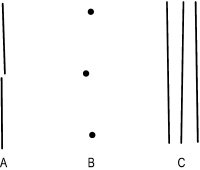hyperacuity
The ability of the eye to detect the differences in the spatial locations of two or more stimuli. Hyperacuity thresholds are not based on resolution and are usually below about 15 seconds of arc. Hyperacuity tests include vernier acuity, stereoscopic acuity, orientation discrimination in which differences in the tilts of lines must be detected, the movement displacement threshold, the vertical alignment of a cluster of dots, or the ability to bisect two parallel lines. Hyperacuity is less affected by optical defocus or light scattering (as occurs for example in corneal leukoma, cataract, vitreous haemorrhage) than is Snellen acuity and can therefore be helpful in assessing macular function behind a cataract or other media opacity before surgery (Fig. H4). See clinical maxwellian view system.
Millodot: Dictionary of Optometry and Visual Science, 7th edition. © 2009 Butterworth-Heinemann
